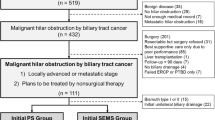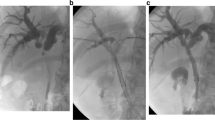Abstract
Aim
To investigate and compare the efficacy and safety of percutaneous transhepatic biliary stenting (PTBS) using a one- or two-stage procedure and determine the predictive factors for the efficacious treatment of malignant hilar obstruction (MHO).
Methods
159 consecutive patients with MHO who underwent PTBS were enrolled between January 2010 and June 2013. Patients were classified into one- or two-stage groups. Independent predictors of therapeutic success were evaluated using a logistic regression model.
Results
108 patients were treated with one-stage PTBS and 51 patients were treated with two-stage PTBS. The stents were technically successful in all patients. Successful drainage was achieved in 114 patients (71.4 %). A total of 42 early major complications were observed. Re-interventions were attempted in 23 patients during follow-up. The cumulative primary patency rates at 3, 6, and 12 months were 88, 71, and 48 %, respectively. Stent placement using a one- or two-stage procedure did not significantly affect therapeutic success, early major complications, median stent patency, or survival. A stent placed across the duodenal papilla was an independent predictor of therapeutic success (odds ratio = 0.262, 95 % confidence interval [0.107–0.642]). Patients with stents across papilla had a lower rate of cholangitis compared with patients who had a stent above papilla (7.1 vs. 20.3 %, respectively, p = 0.03).
Conclusions
The majority of patients with MHO who underwent one-stage PTBS showed similar efficacy and safety outcomes compared with those who underwent two-stage PTBS. Stent placement across the duodenal papilla was associated with a higher therapeutic success rate.






Similar content being viewed by others
Abbreviations
- PTBS:
-
Percutaneous transhepatic biliary stent
- PTBD:
-
Percutaneous transhepatic biliary drainage
- MHO:
-
Malignant hilar obstruction
- MBO:
-
Malignant biliary obstruction
- OR:
-
Odds ratio
- CI:
-
Confidence interval
References
Okuda K, Nakanuma Y, Miyazaki M (2002) Cholangiocarcinoma: recent progress. Part 1: epidemiology and etiology. J Gastroenterol Hepatol 17:1049–1055
de Groen PC, Gores GJ, LaRusso NF, Gunderson LL, Nagorney DM (1999) Biliary tract cancers. N Engl J Med 341:1368–1378
Aljiffry M, Walsh MJ, Molinari M (2009) Advances in diagnosis, treatment and palliation of cholangiocarcinoma: 1990–2009. World J Gastroenterol 15:4240–4262
Cubertafond P, Mathonnet M, Gainant A, Launois B (1999) Radical surgery for gallbladder cancer. Results of the French Surgical Association Survey. Hepatogastroenterology 46:1567–1571
Valero VR, Cosgrove D, Herman JM, Pawlik TM (2012) Management of perihilar cholangiocarcinoma in the era of multimodal therapy. Expert Rev Gastroenterol Hepatol 6:481–495
Jarnagin WR, Ruo L, Little SA et al (2003) Patterns of initial disease recurrence after resection of gallbladder carcinoma and hilar cholangiocarcinoma: implications for adjuvant therapeutic strategies. Cancer 98:1689–1700
Rerknimitr R, Angsuwatcharakon P, Ratanachu-ek T et al (2013) Asia-Pacific consensus recommendations for endoscopic and interventional management of hilar cholangiocarcinoma. J Gastroenterol Hepatol 28:593–607
Saluja SS, Gulati M, Garg PK et al (2008) Endoscopic or percutaneous biliary drainage for gallbladder cancer: a randomized trial and quality of life assessment. Clin Gastroenterol Hepatol 6:944–950
Paik WH, Park YS, Hwang JH et al (2009) Palliative treatment with self-expandable metallic stents in patients with advanced type III or IV hilar cholangiocarcinoma: a percutaneous versus endoscopic approach. Gastrointest Endosc 69:55–62
Kang MJ, Choi YS, Jang JY, Han IW, Kim SW (2013) Catheter tract recurrence after percutaneous biliary drainage for hilar cholangiocarcinoma. World J Surg 37:437–442
Sangchan A, Kongkasame W, Pugkhem A, Jenwitheesuk K, Mairiang P (2012) Efficacy of metal and plastic stents in unresectable complex hilar cholangiocarcinoma: a randomized controlled trial. Gastrointest Endosc 76:93–99
Mukai T, Yasuda I, Nakashima M et al (2013) Metallic stents are more efficacious than plastic stents in unresectable malignant hilar biliary strictures: a randomized controlled trial. J Hepatobiliary Pancreat Sci 20:214–222
Yoshida H, Tajiri T, Mamada Y et al (2003) One-step insertion of an expandable metallic stent for unresectable common bile duct carcinoma. J Nippon Med Sch 70:179–182
Gwon DI, Ko GY, Kim JH et al (2013) Percutaneous bilateral metallic stent placement using a stentin-stent deployment technique in patients with malignant hilar biliary obstruction. AJR Am J Roentgenol 200:909–914
Bae JI, Park AW, Choi SJ et al (2008) Crisscross-configured dual stent placement for trisectoral drainage in patients with advanced biliary hilar malignancies. J Vasc Interv Radiol 19:1614–1619
Gwon DI, Ko GY, Yoon HK et al (2012) Safety and efficacy of percutaneous Y-configured covered stent placement for malignant hilar biliary obstruction: a prospective, pilot study. J Vasc Interv Radiol 23:528–534
Gwon DI, Ko GY, Sung KB et al (2011) Percutaneous biliary metallic stent placement in patients with unilobar portal vein occlusion caused by advanced hilar malignancy: outcome of unilateral versus bilateral stenting. AJR Am J Roentgenol 197:795–801
Kim CW, Park AW, Won JW, Kim S, Lee JW, Lee SH (2004) T-configured dual stent placement in malignant biliary hilar duct obstructions with a newly designed stent. J Vasc Interv Radiol 15:713–717
Ferro C, Perona F, Barile A et al (1994) Treatment of malignant occlusions of bile ducts by one-step technique using metallic endoprostheses. A multicenter study of 50 cases. Radiol Med 88:74–78
Yoshida H, Mamada Y, Taniai N et al (2006) One-step palliative treatment method for obstructive jaundice caused by unresectable malignancies by percutaneous transhepatic insertion of an expandable metallic stent. World J Gastroenterol 12:2423–2426
Akamatsu N, Sugawara Y, Shin N et al (2011) One-step percutaneous transhepatic insertion of a balloon-expanding metallic stent for obstructive jaundice. J Gastroenterol Hepatol 26:1795–1803
Inal M, Aksungur E, Akgul E, Oguz M, Seydaoglu G (2003) Percutaneous placement of metallic stents in malignant biliary obstruction: one-stage or two-stage procedure? Pre-dilate or not? Cardiovasc Interv Radiol 26:40–45
Brountzos EN, Ptochis N, Panagiotou I, Malagari K, Tzavara C, Kelekis D (2007) A survival analysis of patients with malignant biliary strictures treated by percutaneous metallic stenting. Cardiovasc Intervent Radiol 30:66–73
Hatzidakis AA, Tsetis D, Chrysou E, Sanidas E, Petrakis J, Gourtsoyiannis NC (2001) Nitinol stents for palliative treatment of malignant obstructive jaundice: should we stent the sphincter of Oddi in every case? Cardiovasc Intervent Radiol 24:245–248
Cardella JF, Kundu S, Miller DL, Millward SF, Sacks D (2009) Society of Interventional Radiology clinical practice guidelines. J Vasc Interv Radiol 20:S189–S191
Gandini R, Fabiano S, Pipitone V et al (2005) Management of biliary neoplastic obstruction with two different metallic stents implanted in one session. Cardiovasc Intervent Radiol 28:48–52
Dumonceau JM, Tringali A, Blero D et al (2012) Biliary stenting: indications, choice of stents and results: European Society of Gastrointestinal Endoscopy (ESGE) clinical guideline. Endoscopy 44:277–298
Walter T, Ho CS, Horgan AM et al (2013) Endoscopic or percutaneous biliary drainage for Klatskin tumors? J Vasc Interv Radiol 24:113–121
Valle J, Wasan H, Palmer DH et al (2010) Cisplatin plus gemcitabine versus gemcitabine for biliary tract cancer. N Engl J Med 362:1273–1281
Lee SH, Park JK, Yoon WJ et al (2007) Optimal biliary drainage for inoperable Klatskin’s tumor based on Bismuth type. World J Gastroenterol 13:3948–3955
Al-Bahrani AZ, Holt A, Hamade AM et al (2006) Acute pancreatitis: an under-recognized risk of percutaneous transhepatic distal biliary intervention. HPB (Oxford) 8:446–450
Savader SJ, Venbrux AC, Robbins KV, Gittelsohn AM, Osterman FA (1991) Pancreatic response to percutaneous biliary drainage: a prospective study. Radiology 178:343–346
Choi SH, Gwon DI, Ko GY et al (2011) Hepatic arterial injuries in 3110 patients following percutaneous transhepatic biliary drainage. Radiology 261:969–975
Kone BC, Watson AJ, Gimenez LF, Kadir S (1986) Acute renal failure following percutaneous transhepatic cholangiography. A retrospective study. Arch Intern Med 146:1405–1407
Gwon DI, Ko GY, Kim JH et al (2010) A comparative analysis of PTFE-covered and uncovered stents for palliative treatment of malignant extrahepatic biliary obstruction. AJR Am J Roentgenol 195:W463–W469
Almadi MA, Barkun AN, Martel M (2013) No benefit of covered vs uncovered self-expandable metal stents in patients with malignant distal biliary obstruction: a meta-analysis. Clin Gastroenterol Hepatol 11:27–37
Thornton RH, Ulrich R, Hsu M et al (2012) Outcomes of patients undergoing percutaneous biliary drainage to reduce bilirubin for administration of chemotherapy. J Vasc Interv Radiol 23:89–95
Acknowledgments
We thank Wengang Guo, Jing Niu, and Na Han for their efforts in the preservation of all imaging data, surveillance, and collection of follow-up information.
Conflict of Interest
The all authors including Mingwu Li, Ming Bai, Xingshun Qi, Kai Li, Zhanxin Yin, Jianhong Wang, WenbingWu, Luanluan Zhen, Chuangye He, Daiming Fan, Zhuoli Zhang, and Guohong Han of this study have no conflicts of interest.
Statement of Informed Consent
Informed consent was obtained from all individual participants included in the study
Statement of Human and Animal Rights
All procedures performed in study involving human participants were in accordance with the ethical standards of the institutional and/or national research committee and with the 1964 Helsinki declaration and its later amendments or comparable ethical standards.
Author information
Authors and Affiliations
Corresponding author
Additional information
Mingwu Li, Ming Bai, Xingshun Qi, Kai Li, Zhanxin Yin, Jianhong Wang, Wenbing Wu, Luanluan Zhen, Chuangye He, Daiming Fan, and Zhuoli Zhang contributed equally to this study.
Rights and permissions
About this article
Cite this article
Li, M., Bai, M., Qi, X. et al. Percutaneous Transhepatic Biliary Metal Stent for Malignant Hilar Obstruction: Results and Predictive Factors for Efficacy in 159 Patients from a Single Center. Cardiovasc Intervent Radiol 38, 709–721 (2015). https://doi.org/10.1007/s00270-014-0992-0
Received:
Accepted:
Published:
Issue Date:
DOI: https://doi.org/10.1007/s00270-014-0992-0




